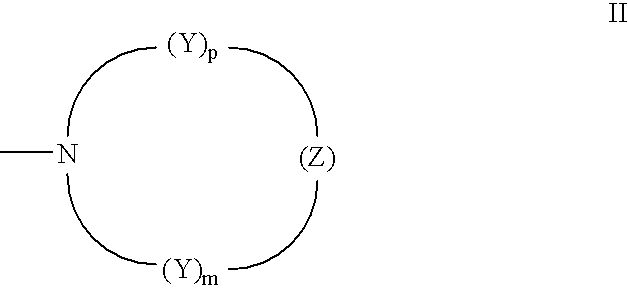Photochromic indeno-fused naphthopyrans
a technology of indeno-fused naphthopyrans and photochromic materials, which is applied in the direction of photosensitive materials, camera filters, instruments, etc., can solve the problem that the vision of the wearer may be less than optimal
- Summary
- Abstract
- Description
- Claims
- Application Information
AI Technical Summary
Benefits of technology
Problems solved by technology
Method used
Image
Examples
example 1
Step 1
[0105]Piperidine (23.4 grams (“g”)), 4,4′-difluorobenzophenone (60 g), triethylamine (30.6 g) were added to a reaction flask containing 100 milliliters (“mL”) of dimethylsulfoxide. The resulting mixture was heated to 105° C. and stirred overnight under a nitrogen atmosphere. After 24 hours at 105° C., the reaction was quenched into 1400 mL of water with vigorous stirring to see a light brown solid precipitate out. The solid was filtered, washed with water and dried open to air to obtain 79.5 g of the desired product, 4-fluoro-4′-piperidinobenzophenone. This material was used in the next step without further purification.
Step 2
[0106]The product of Step 1, 4-fluoro-4′-piperidinobenzophenone (78 g) was added to a reaction flask containing 500 mL of N,N-dimethylformamide saturated with acetylene. The resulting mixture was stirred using a mechanical stirrer at room temperature under a nitrogen atmosphere. Sodium acetylide in xylenes / mineral oil (73.5 g of a 18% by weight solution) ...
example 2
Step 1
[0112]The product of Example 1, Step 2 in U.S. Pat. No. 5,645,767 (1-phenyl-2-methoxycarbonyl-4-acetoxynaphthalene, 50 g) was added to a reaction flask containing 500 mL of tetrahydrofuran. The resulting mixture was cooled in an ice water bath and stirred under a nitrogen atmosphere. 703 mL of a methyl magnesium chloride solution (1M in tetrahydrofuran) was added dropwise over forty-five minutes. The resulting yellow reaction mixture was stirred at 0° C. for 2 hours and slowly warmed to room temperature. The reaction mixture was poured into 2 L of an ice / water mixture. Ethyl ether (1 L) was added, and the layers separated. The aqueous layer was extracted with two 500 mL portions of ether, and the organic portions were combined and washed with 1 L of water. The organic layer was dried over anhydrous sodium sulfate and concentrated by rotary evaporation. The resulting oil was transferred into a reaction vessel (fitted with a Dean-Stark trap) containing 500 mL of toluene to which...
example 3
[0114]The product of Example 1, Step 6 (3,9-difluoro-7,7-dimethyl-5-hydroxy-7H-benzo[C]fluorene, 5.0 g), 1-(4-fluorophenyl)-1-(4-morpholinophenyl)-2-propyn-1-ol (5.3 g), 7 drops of methane sulfonic acid and 200 mL of chloroform were combined in a reaction flask and stirred at reflux temperatures under a nitrogen atmosphere. After one hour, an additional 5.0 g of the 1-(4-fluorophenyl)-1-(4-morpholinophenyl)-2-propyn-1-ol was added to the reaction mixture and the heating continued. After two hours, an additional 2.0 g of the 1-(4-fluorophenyl)-1-(4-morpholinophenyl)-2-propyn-1-ol and 4 drops of methane sulfonic acid were added to the reaction mixture. The reaction mixture was heated for another four hours, and then cooled to room temperature. The reaction mixture was washed carefully with a mixture of 125 mL of a saturated sodium bicarbonate solution and 125 mL of water. The organic layer was separated, dried over sodium sulfate, and concentrated by rotary evaporation. The residue wa...
PUM
| Property | Measurement | Unit |
|---|---|---|
| wavelengths | aaaaa | aaaaa |
| wavelength | aaaaa | aaaaa |
| weight | aaaaa | aaaaa |
Abstract
Description
Claims
Application Information
 Login to View More
Login to View More - R&D
- Intellectual Property
- Life Sciences
- Materials
- Tech Scout
- Unparalleled Data Quality
- Higher Quality Content
- 60% Fewer Hallucinations
Browse by: Latest US Patents, China's latest patents, Technical Efficacy Thesaurus, Application Domain, Technology Topic, Popular Technical Reports.
© 2025 PatSnap. All rights reserved.Legal|Privacy policy|Modern Slavery Act Transparency Statement|Sitemap|About US| Contact US: help@patsnap.com



